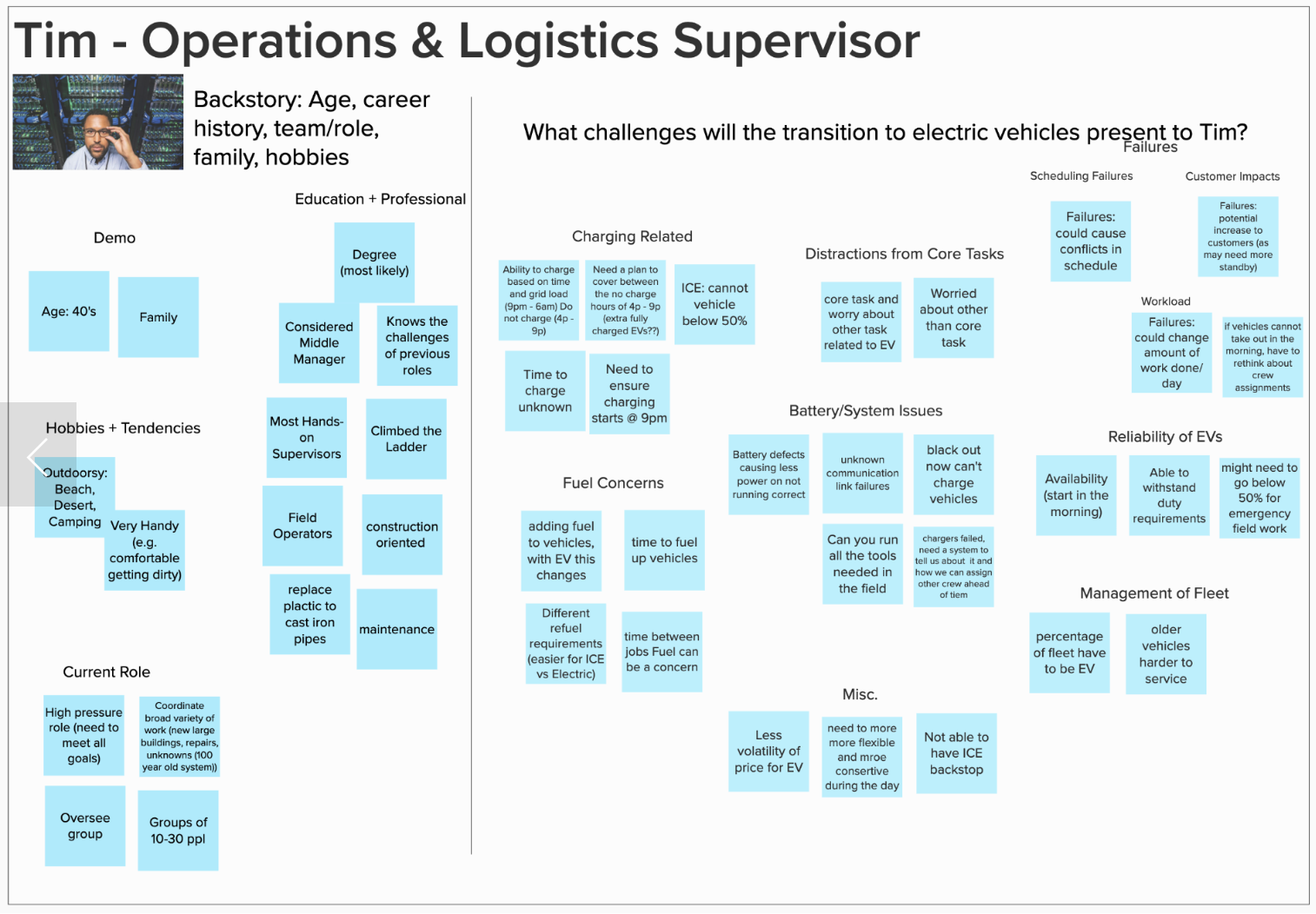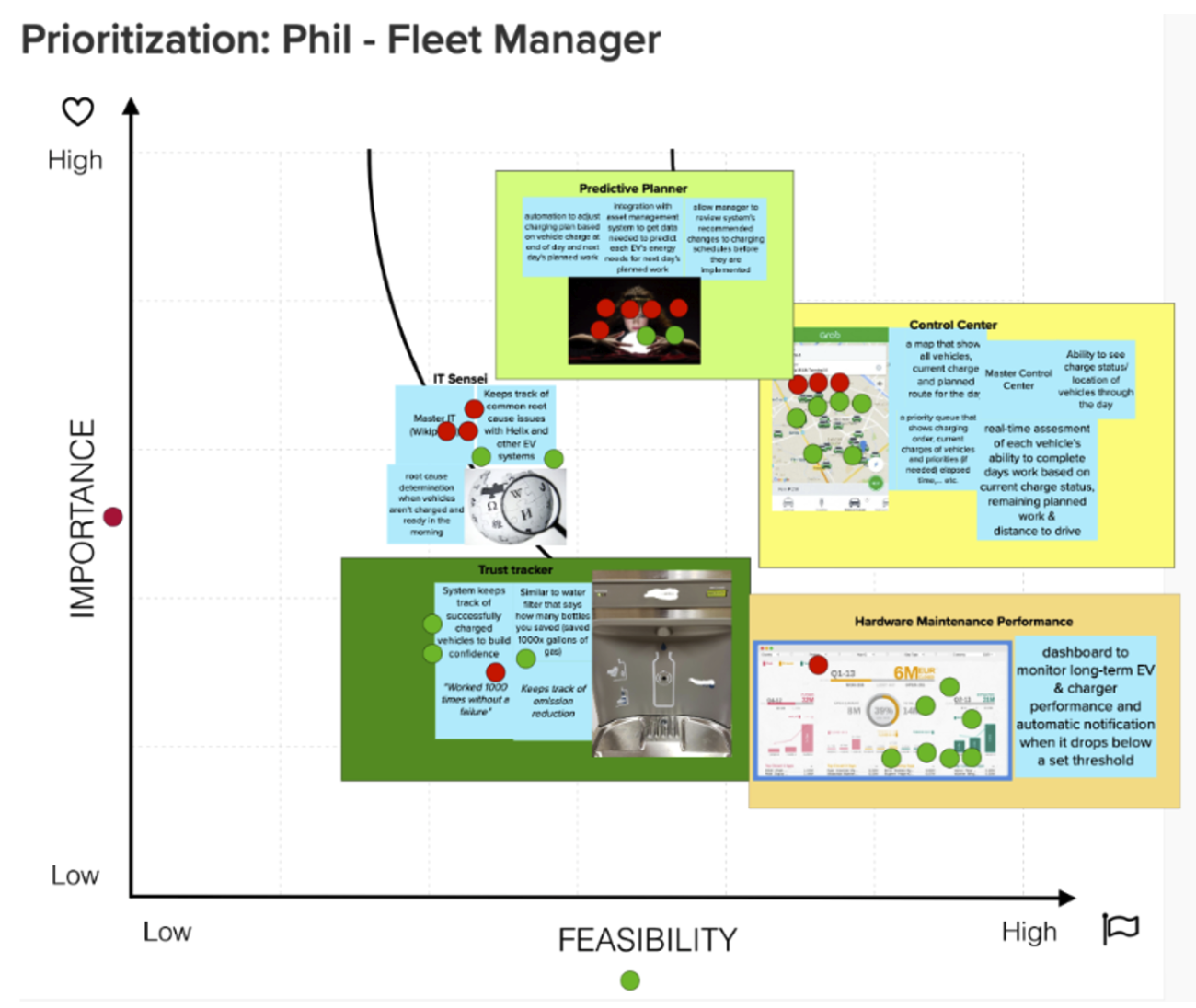Electric Vehicle Infrastructure Design
Helping a California public utility align user needs, technical systems, and policy mandates to design a smart EV charging platform.
⚡ The Challenge
Helix Water District, a public utility in California, needed to comply with the state’s 2025 EV mandate. They required a scalable, intelligent system to manage a mixed fleet of electric vehicles and equipment.
- Operate 24/7 and support emergency response
- Optimize energy use and scheduling
- Integrate with evolving infrastructure needs
🎯 Project Goals
- Define MVP scope and system requirements
- Map user pain points and workflows
- Align technical feasibility with business needs
- Reduce risk through early validation
- Deliver a phased roadmap for implementation
Team & My Role
My Role
I served as the Lead UX Designer and project facilitator, managing the engagement from kickoff through delivery. I led cross-functional collaboration, facilitated all workshops, and translated user and business insights into actionable strategy, prototypes, and MVP direction.
IBM Garage Team
- Lead UX Designer (me)
- Technical Engineer
- Solutions Architect
- Distinguished Engineer
- Solutions Engineer
- Principal Data Scientist
- Junior Designer
- Customer Success Manager
- Account Executive
- Business Technology Leader
Helix Water District Team
- Director of Information Technology
- Operations Director
- Operations Manager
- Facilities Manager
- SCADA Programming & Wireless Network Admin
- Equipment Maintenance Coordinator
- Valve Maintenance Technician
Approach
We facilitated three collaborative workshops to guide discovery, define the future state, and map the path to implementation. Each workshop included experts from Helix Water District and IBM, combining technical depth with human-centered design methods.
Workshop 1
Business FramingStakeholders, Personas, Risks
Workshop 2
Technical DiscoveryFuture State, Ideation, Prioritization
Workshop 3
Use Case & MVP PlanningRoadmaps, Storyboards, Capabilities
Workshop 1: Business Framing - Goals
- Understand current and future stakeholders responsible for EV implementation and system management
- Identify key users affected by the 2025 EV mandate
- Define the desired future state and how it will impact those users
Stakeholder Mapping
We began by identifying the full landscape of people affected by the EV transition—from field technicians and system operators to grant managers and ratepayers. This ensured we captured operational realities early and didn’t overlook voices that could affect success.
Government entities, Citizens
CPUC, SDG&E, Air Pollution Control District
Mutual aid partners
Vehicle maintenance vendors and dealer relationships
Charging station and equipment partners
Fuel island tracking, asset management, and data security
Field Team: Operations Crews, Valve Techs, Distribution Operators
Persona Development
To align understanding across the team, we co-created two key personas: "Tim," an Operations & Logistics Supervisor, and "Phil," a Fleet Manager. These personas helped us explore how responsibilities, priorities, and daily workflows would evolve in a fully electric fleet environment. The exercise surfaced operational challenges and ensured the solution would support both frontline and strategic decision-making roles.
Requirements Exploration
We used a Need to Have / Nice to Have matrix to prioritize the most critical features for the proof of concept. This helped clarify what should be validated first and which enhancements could follow later, allowing the team to move forward with clarity.
Need to Haves
- Intelligently orchestrates charging of multiple vehicles
- EV will have charge priority of high, normal, and low
- Intelligently knows which vehicle has more priority
- First responder status/priority
- Ability to handle electricity rates as configuration parameter
- Manage seasonal rates and off-peak hours to prioritize charging on lower rates
- Mobile app for privileged user to override AI orchestration
Nice to Haves
- Project future charging costs based on current usage/season/rates
- AUDIT logs for overrides
- Monitoring the vehicle battery life as configuration parameter
- Optimize battery life
- System accrues the impact of configuration on battery performance
- Solar charging for powerwall
- Monitor health when plugged in
- Wired network preferred over wireless
- Data feeds into AI model for predictive monitoring
Assumptions & Risk Mapping
We surfaced key assumptions behind the proposed system and used a structured matrix to assess risks. This helped reduce uncertainty and identify areas requiring validation or prototyping.
| Assumption | Associated Risk |
|---|---|
| The system will support simultaneous charging of multiple vehicles on a shared charger | If this is incorrect, charging throughput will be limited, requiring more infrastructure and increasing costs |
| EV chargers across facilities will follow the same standards and offer similar performance | If chargers vary in compatibility or speed, users may face delays and system integration could become more complex |
| Type 3 chargers will have the ability to store energy | Increased operational cost |
| All vehicle data will be encrypted in flight and at rest | Security breach potential increases |
| Data retention is 5 years | Data retention is out of regulatory compliance |
Workshop 1: Business Framing Workshop - Outcomes
- Shared view of stakeholders and system impact
- Defined critical system capabilities for POC
- Identified and prioritized risks for mitigation
With the foundation in place, we shifted focus to how the future system should actually work. The second session, our Technical Discovery Workshop, was about surfacing real-world challenges and generating ideas that could lead directly into design.
Workshop 2: Technical Discovery - Goals
- Identify potential pain points key users may encounter with the future EV infrastructure
- Generate ideas to alleviate those pain points in the future state
- Prioritize key initiatives for each persona to guide design and implementation focus
🔮 To-Be Journey Mapping
We created a future-state journey map for EV fleet managers, visualizing tasks, thoughts, and emotions. The map helped surface system breakdowns and inform high-impact opportunities.
- Build trust in the system’s reliability
- Automate charge planning to reduce manual effort
- Identify root causes when vehicles aren’t ready
💡 Big Ideas: Ideation & Dot Voting
In a collaborative ideation session, participants generated forward-looking ideas to address user pain points. We used green and red dot voting to evaluate each idea’s importance to users and feasibility to implement.
Prioritization Mapping
After stakeholders from Helix voted on the value and feasibility of each idea, the IBM team reviewed the results to place each idea on a prioritization grid. Ideas were grouped into four categories:
- No Brainers: High importance and high feasibility
- Big Bets: High importance with moderate feasibility
- Utilities: High feasibility with moderate importance
- Backlog: Lower importance and feasibility
Workshop 2: Technical Discovery Workshop - Outcomes
- Clear view of top technical and human challenges
- Co-created solutions rooted in operational needs
- Prioritized ideas to guide roadmap planning
With user needs mapped and top-priority ideas defined, the team shifted focus toward implementation. The third session, our Use Case and MVP Planning Workshop, centered on translating concepts into action through storyboards, phased roadmaps, and capability mapping to guide development.
Workshop 3: Use Case and MVP Workshop - Goals
- Translate top ideas into storyboards to align on vision and scenarios
- Build phased roadmaps to prioritize feature development
- Identify capability needs and technical considerations to guide execution
Storyboarding
To bring ideas to life, we facilitated a collaborative storyboarding session. Team members sketched proposed user experiences, then synthesized them into shared narratives. This turned abstract features into concrete, human-centered flows.
👨💼 Joe - Operations Manager
Intelligence & Predicting Disruptions
Joe starts his day checking the predictive intelligence dashboard
System alerts him to potential disruptions in the supply chain
AI provides detailed analysis and recommended preventive actions
Joe communicates proactively with stakeholders using automated alerts
Preventive measures are implemented before disruptions occur
Operations continue smoothly with minimal impact and documented savings
👩💼 Maxine - Fleet Manager
Vehicle Optimization & Charging
Maxine notices irregular vehicle performance patterns affecting delivery efficiency
She accesses the optimization dashboard to analyze vehicle data and charging patterns
System provides automated recommendations for optimal charging schedules and routes
Maxine implements suggested optimizations with one-click deployment
Real-time monitoring shows immediate improvements in efficiency metrics
Cost savings and performance gains are automatically calculated and reported
Experience-Based Roadmaps
We grouped the strongest ideas into two strategic themes called Predictive Planner and IT Sensei, and mapped how each capability would evolve over time. These roadmaps balanced technical feasibility with user value.
Experience-Based Roadmap
| Time Horizon | Control Center & Maintenance | Charging & Optimization |
|---|---|---|
| Short Term |
• View real-time charge status • Be alerted to charge failures • Quickly identify root causes |
• Estimate cost per charge • Confirm charge started • Track charger usage by vehicle |
| Mid Term |
• Track hardware performance • Predict failures before downtime |
• Predict charge duration • Optimize charger assignment • Generate cost-saving reports |
Experience-Based Roadmaps
We grouped the strongest ideas into two strategic themes called Predictive Planner and IT Sensei, and mapped how each capability would evolve over time. These roadmaps balanced technical feasibility with user value.
Experience-Based Roadmap
| Time Horizon | Control Center & Maintenance | Charging & Optimization |
|---|---|---|
| Short Term |
• View real-time charge status • Be alerted to charge failures • Quickly identify root causes |
• Estimate cost per charge • Confirm charge started • Track charger usage by vehicle |
| Mid Term |
• Track hardware performance • Predict failures before downtime |
• Predict charge duration • Optimize charger assignment • Generate cost-saving reports 🚀
Workshop 3: Use Case & MVP Planning Outcomes
🛠️
SolutionOur research confirmed the need for a unified platform to monitor vehicle status, charge progress, job scheduling, and intelligent prioritization. We identified Maximo Application Suite (MAS) as the ideal platform and built a working prototype that visualized charger and vehicle data in a single dashboard. This helped validate the concept and showed Helix leadership how the system could meet operational goals. 📈
ImpactProject Impact
Business Results
🎯
Final TakeawayThis project showed how fast, collaborative design grounded in systems thinking can bring clarity to complex infrastructure challenges. We helped Helix Water District move from ambiguity to a clear, validated path forward, aligning business priorities, technical feasibility, and human needs. |








